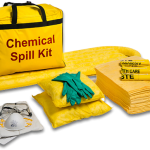Introduction
Oil spills are environmental disasters that can have severe consequences on ecosystems, wildlife, and human health. Rapid and effective response is crucial to mitigate the impact of these spills. Oil spill kits play a vital role in providing the tools and resources needed for immediate containment and cleanup. In this blog post, we will delve into the world of oil spill kits, exploring their types and applications to better understand how they contribute to environmental protection.
General Overview of Oil Spill Kits: Purpose and Components
Oil spill kits are specially designed packages that contain a variety of materials and equipment to quickly respond to and contain oil spills. These kits are tailored to address different scales of spills, from small incidents in industrial settings to large-scale environmental disasters. Components typically found in oil spill kits include absorbents, barriers, protective gear, and disposal bags.
Types of Oil Spill Kits: Tailored Solutions for Every Scenario
a. Universal Oil Spill Kits:
- Designed to handle a variety of liquids, including oils, fuels, and water.
- Suitable for responding to spills in industrial settings, manufacturing facilities, and transportation incidents.
b. Marine Oil Spill Kits:
- Specifically crafted for spills that occur on water surfaces, such as oceans, rivers, or lakes.
- Include floating barriers and booms to contain and control the spread of oil on water.
c. Oil-Only Spill Kits:
- Geared towards situations where only hydrophobic substances like oils and fuels need to be absorbed.
- Ideal for environments where water is not a concern, ensuring efficient oil absorption.
d. Hazardous Material (HAZMAT) Oil Spill Kits:
- Tailored for spills involving hazardous chemicals or substances.
- Equipped with specialized absorbents and neutralizing agents to handle dangerous materials safely.
Key Components in Oil Spill Kits
a. Absorbents:
- Various materials like pads, rolls, and socks designed to soak up and contain spilled oil.
- Choosing the right absorbent depends on the type of oil and the specific environment.
b. Barriers and Booms:
- Physical barriers to prevent the spread of oil in water.
- Booms are floating devices strategically deployed to contain and control the movement of oil on water surfaces.
c. Personal Protective Equipment (PPE):
- Essential gear including gloves, goggles, and coveralls to protect responders from exposure to hazardous substances.
Applications of Oil Spill Kits
a. Industrial Facilities:
- Responding to oil spills resulting from equipment malfunctions or leaks in industrial settings.
b. Transportation Incidents:
- Quick response to oil spills from accidents involving trucks, pipelines, or other modes of transportation.
c. Marine Environments:
- Addressing oil spills in oceans, rivers, or lakes to prevent ecological damage and protect aquatic life.
d. Hazardous Material Handling:
- Managing spills of hazardous chemicals with specialized HAZMAT oil spill kits.
Conclusion
Oil spill kits are indispensable tools in the fight against environmental pollution. By understanding the various types and applications of these kits, responders can effectively choose and utilize the right tools for different scenarios. Rapid response and proper application of oil spill kits are essential not only to minimize the impact on the environment but also to protect the health and safety of individuals involved in cleanup efforts. Continuous training and awareness programs further enhance the preparedness of organizations in dealing with oil spills, contributing to a more sustainable and resilient environment.


